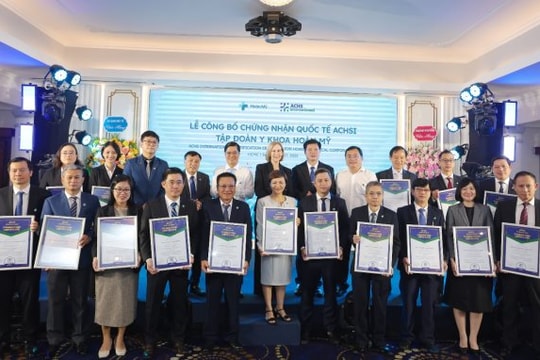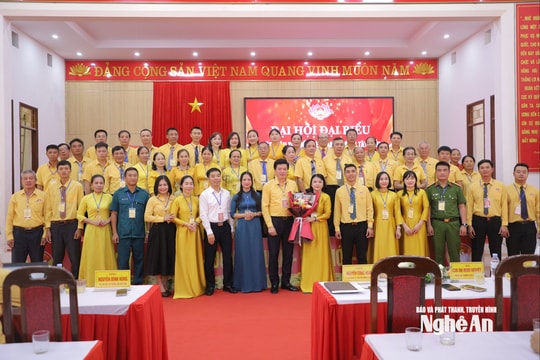Memoirs of the first Minister of Information and Communications
More than 9 years have passed, but the memories of the first day he took on the responsibility of the first Minister of the Ministry of Information and Communications (MIC) and the initial activities of the multi-sectoral Ministry are still intact in the mind of Dr. Le Doan Hop.
Early days with 5 priority jobs
On the occasion of the first time the entire Information and Communications sector enthusiastically celebrated the founding day of the Information and Communications sector (August 28), the reporter met with Dr. Le Doan Hop, the first Minister of the Ministry of Information and Communications, to learn more about this unforgettable milestone in the historical development of the sector.
 |
| Dr. Le Doan Hop, the first Minister of the Ministry of Information and Communications. |
With the mindset of an insider, Dr. Le Doan Hop still remembers clearly the stories from more than 9 years ago. That was in 2007, when the Ministry of Information and Communications was established on the basis of the Ministry of Posts and Telecommunications merging the Press Department and the Publishing Department under the former Ministry of Culture and Information.
“At that time, the Central Government had a policy to establish a multi-sectoral Ministry with fields that had causal relationships with each other, were linked together and were the premise for each other. On that basis, the issue of reorganizing the Ministry of Posts and Telecommunications was raised in association with the Press - Publishing sector of the Ministry of Culture - Information into the Ministry of Information and Communications. That orientation aimed to connect infrastructure and content (communication is infrastructure, information is content) so that these two sectors could be linked together to maximize efficiency, such as connecting railways with trains, runways with airplanes, roads with cars. The Ministry of Information and Communications was born like that,” Dr. Le Doan Hop began the story with the Vietnam Post Newspaper.
The merger and formation of the Ministry of Information and Communications was carried out very quickly. Assigned to be the first Minister of the Ministry of Information and Communications, Dr. Le Doan Hop had to face a lot of work to do. However, he and the leaders of the Ministry at that time quickly identified the first 5 things that needed to be done immediately.
The first is to complete the determination of the functions, tasks and authority of the Ministry of Information and Communications. With great determination, in just about 4 months, Decree No. 187/2007 on the functions, tasks and authority of the Ministry of Information and Communications with 5 management areas (including: Press, Publishing, Post, Telecommunications, Information Technology) was completed.
The second is to establish a system of specialized agencies to fulfill the functions and tasks clearly stated in Decree 187. A number of new units were established such as the Department of Radio - Television and Electronic Information, the Department of Foreign Information, the Department of Telecommunications, the School of Training and Fostering Information and Communications Management Staff (at that time, there was also a direction to establish a University of Information and Communications covering 5 majors to ensure specialization and professionalization).
Third, assigning cadres, leaders and reviewing cadres in charge to meet the requirements of the new functions and tasks of the Ministry of Information and Communications. Highly appreciating this work, the first Minister of the Ministry of Information and Communications recounted: “At that time, I told my colleagues that the Ministry's leaders did not raise the issue of replacing people but only required a change in the way of working. Only replace cadres in charge when cadres do not change the way of working according to the new requirements. When assigning responsibilities to Deputy Ministers; I determined that the Minister would do the tasks that were difficult for the Deputy Minister to do or that would produce slower results. Whatever the subordinates could do, they would be fully assigned to the subordinates, and the superiors would be responsible for examining, urging, praising, criticizing, rewarding and punishing. Only then would the strategic and tactical levels be clear.”
The next priority task is to complete the institution. With the determination of the first Minister of Information and Communications and the leaders of the Ministry at that time, during the first term of the Ministry of Information and Communications, 4 new laws were issued (Law on Radio Frequency, Law on Telecommunications, Law on Post, Law on Publishing amended).
“All of those laws are embedded in the most important, consistent, and necessary idea, which is to gradually socialize infrastructure. I am a supporter of the private economy, always considering the private economy as an important driving force for the country’s development. Since 1990, I have done my doctoral thesis on urban household economy in a market mechanism. I think the vitality of every regime is still the private economy, and I want to support the private economy to have a lesson in reforming the state economy, fundamentally changing the thinking of state managers.
And the fifth priority task is to identify key strategies, promote the greatest advantages of the country and the industry to complete assigned functions and tasks.
And 5 strategies of the times
The first Minister of the Ministry of Information and Communications was a person who was quite attached to Culture and Information. Many people thought that one of the first key strategies of the Ministry of Information and Communications would be related to Press or Publishing.
However, the first of the five key strategies identified by the leaders of the Ministry of Information and Communications is to soon make Vietnam a strong country in IT-TT, a field in which Dr. Le Doan Hop is an "outsider".
“We identified this as the number 1 strategy because Vietnam has 3 advantages, if we do not act quickly, we will lose the opportunity. The first advantage is that the country has a golden labor force, 70% of the workforce is under 40 years old. The second advantage is that the young generation of Vietnam is very passionate about technology. There are many talented software industry workers in our country, many of whom earn 100,000 USD per month, 1.2 million USD per year. If we do not take advantage of this opportunity, the young generation will not have an environment to contribute their talents. The third advantage is that we are behind, there are many lessons from the countries that have gone before to take shortcuts and break through faster. With those 3 bases, I directly reported to Prime Minister Nguyen Tan Dung and the Prime Minister agreed on the policy. After that, I returned to direct the whole Ministry to get involved, it took 18 months to pass the Project. This is an international strategy, of the era, also demonstrating the mindset of following Uncle Ho's words: "strive "Fight soon to bring Vietnam on par with the world powers."
The second key strategy that has been implemented quite systematically by the leaders of the Ministry of Information and Communications is to bring information to the grassroots. “We realize that if information is not brought to the grassroots, mountainous, remote and isolated areas will be both materially hungry and informationally poor, and informationally hungry will find it difficult to escape material poverty. However, we must persevere to get the Government and the National Assembly to agree to supplement the formation of a National Target Program to bring information to the grassroots with the policy of bringing 5 terminal devices to households (including: telephone, computer, Internet, television, radio...). That is a revolution to revive awareness to innovate action. When I reported to the President of the International Telecommunication Union ITU, the President said that if Vietnam brings these terminal devices to households, Vietnam will be one of the civilized countries of mankind. Telecommunications enterprises contribute capital to the Public Telecommunications Fund to carry out this important task.
Next, the third key strategy is human resource training, with three priorities: Training and fostering managers; Training leading staff; and Intensive training of information technology engineers.
Particularly passionate about the field of training software engineers, Dr. Le Doan Hop enthusiastically shared: “Each good software engineer can make 1 million USD each year. If we have about 1 million software engineers, our country will flourish. And those who make software get rich by selling software to other countries, that is, taking money from the world to the country to help farmers more. At that time, I suggested that all technical universities should have an IT department; IT schools need to focus on training key people, cooperate with Israel to train IT experts. If we focus on direction, get government investment to stimulate demand to do it, then everything will certainly be much more fun and optimistic now.
The fourth key strategy of the Ministry of Information and Communications in the early period was to inherit the foreign affairs achievements of previous generations, continue to expand international cooperation and compete comprehensively. According to the analysis of former Minister Le Doan Hop, “Vietnam's weakest point is that it does not compete, likes monopoly and subsidies. There must be comprehensive competition for the people to benefit. At the same time, we must know how to cooperate with the world, choose the strongest points of Vietnam such as land, people, traditions, culture, combined with the strongest points of foreign countries such as market, brand, financial capacity, action thinking, thereby creating new strength. When going abroad, we must be brave to compare ourselves with the world, in each field, see who we are, where we are and what we must do to not lose to others or friends. Thanks to that, Vietnam's Telecommunications and Information Technology today are on par with the international level.” Along with expanding international cooperation, it is necessary to take care of synchronously connecting with localities, businesses and establishments in the direction of deep cooperation and wide association, ensuring rapid, sustainable development, and internal innovation in sync with external integration.
The fifth strategy is: Taking care of political and ideological work, perfecting and consolidating mass organizations. Linking ideological work with political tasks, connecting mass work with professional tasks. Strengthening human resources, clearly linking each political position with the authority and personal interests of mass organizations such as Youth, Women, Veterans, and Trade Unions. Having policies to encourage full-time workers and motivate part-time workers. All political activities such as studying the Resolution, updating current information, mechanisms, policies, meeting with women workers, youth, trade unions, and veterans on traditional days, the Party Committee Secretary takes time to attend, encourage, answer questions, and guide actions. The Ministry's leadership assigns a deputy minister to concurrently take on Party and Mass Organization work. Creating a political atmosphere of trust, democracy, creativity, solidarity, and cooperation for the common mission, working together to best complete the professional tasks of a new multi-sectoral, multi-field ministry, right from the first days of its establishment, creating momentum and strength, lessons and good experiences for the next stage.
According to Infonet







.jpg)
